Generating Alt Text
The AltText.ai website lets you manually generate alt text for individual images, as well as bulk generation via CSV imports and web page scrapes.
Processing a Single Image
To generate alt text for an image:
- Go to your Images library on the website.
- Click the +Image button.
- Enter either the image URL, or click the Choose File button to upload an image from your computer.
-
Click Add Image to submit.
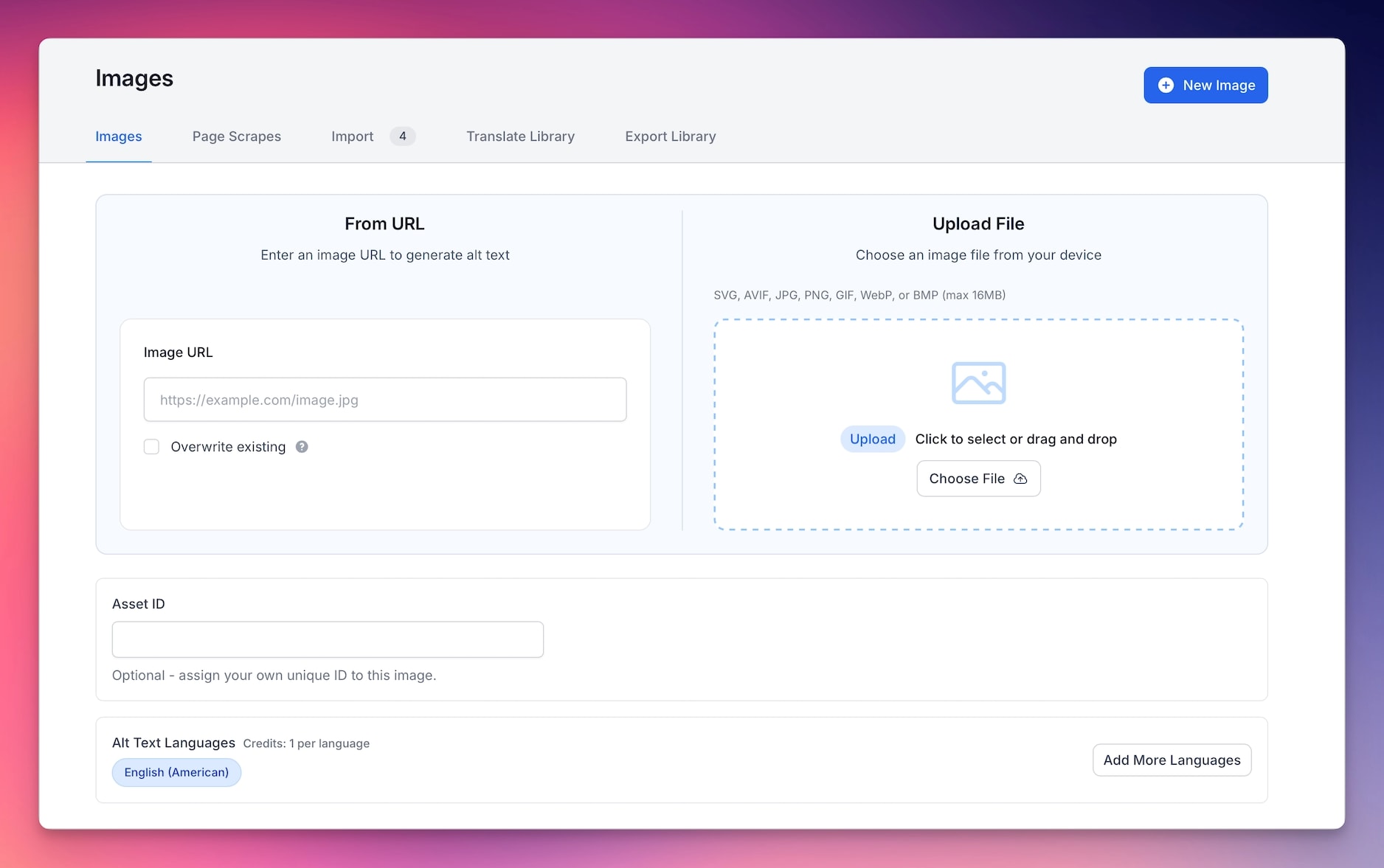
Other Image Properties
Asset ID
Use this field to set your own unique identifier for the image. If left blank, a random ID will be assigned. The asset ID is useful if you plan on exporting your image data to use in your own system, and you need a way to tie the image back to your own internal identifier.
Alt Text Language
Set the language for the generated alt text. By default this value is set to your Account's default language. We support over 130 languages for alt text.
Ecommerce Images
If you are processing ecommerce images, select the Ecommerce Data checkbox to enter your product name and brand. AltText.ai will intelligently add these into your alt text.
Adding SEO Keywords
To enhance your alt text with specific keywords/phrases, or exclude specific keywords (negative keywords), select the SEO Keywords checkbox, then enter your keywords:
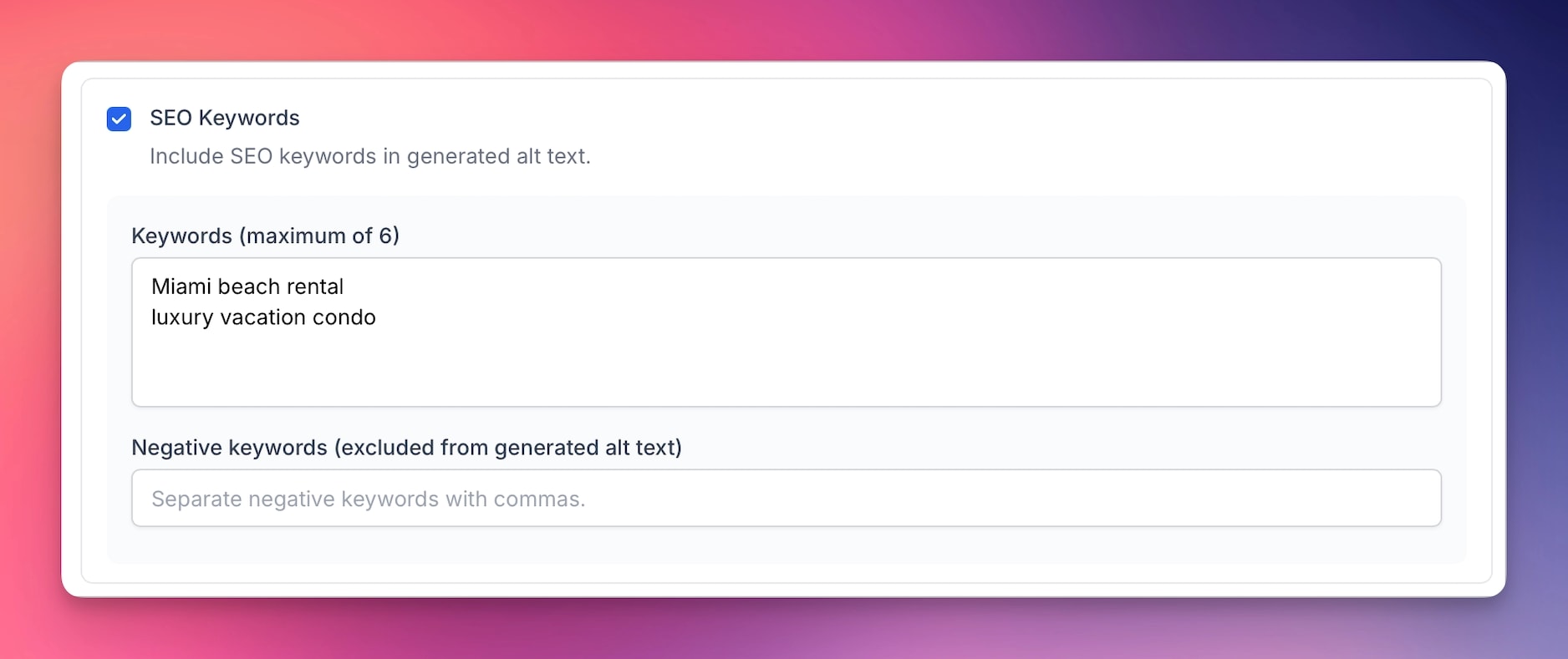
Using ChatGPT Modification
You can process the generated alt text through ChatGPT in order to add your own custom enhancements. It works like this:
Initial alt text ==> ChatGPT (with your prompt) ==> Final alt text for your image
When you check the box for ChatGPT modification, you will be asked to supply a ChatGPT prompt which will be
used to transform the initial alt text into your final alt text for the image. Your prompt MUST include
the macro {{AltText}} which will be where the initial alt text is added when sent to ChatGPT.
Important
ChatGPT modification does not see the image. It only receives the already-generated alt text as input and modifies that text based on your prompt. ChatGPT cannot analyze the visual content of your images.
Note
ChatGPT prompts must be written in English, even if you are generating alt text in another language.
Example: Say your website sells surfboards, and you want to use your own custom brand voice for alt text.
You could supply a prompt like this: Rewrite the following text in the style of a California surfer dude: {{AltText}}
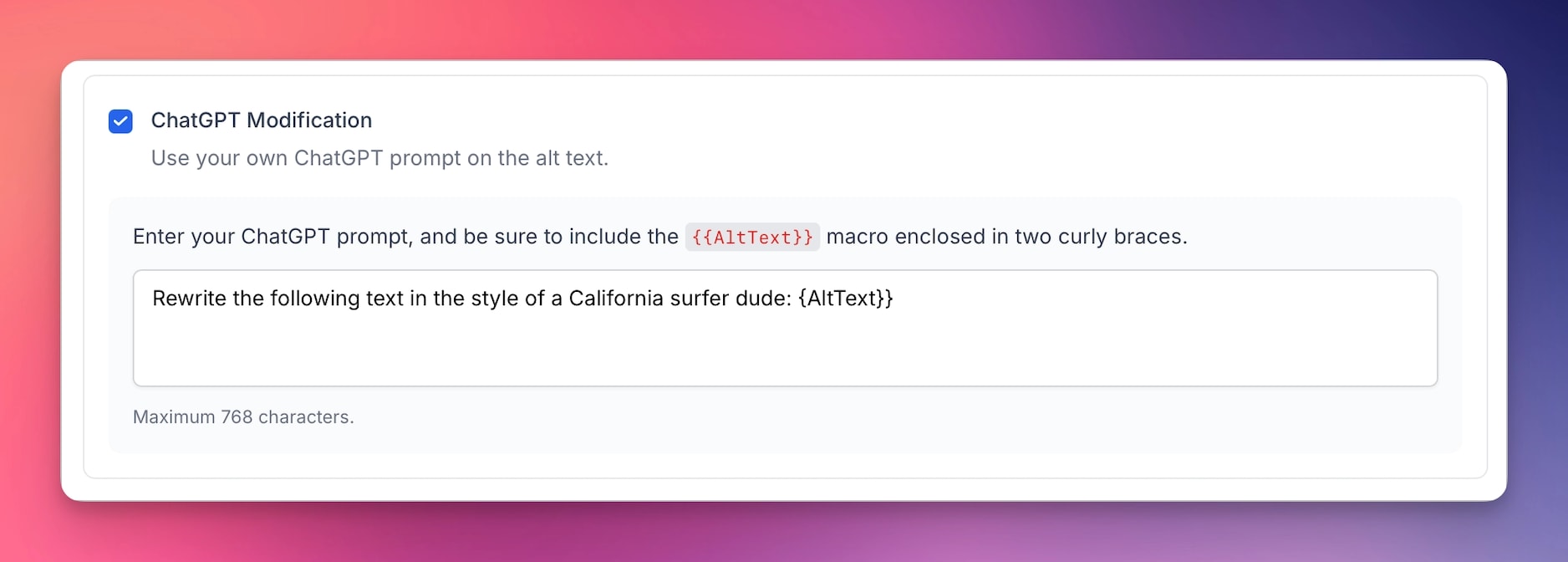
Info
To use the same ChatGPT prompt every time you generate alt text, set up the prompt in your Account: Settings page.
Bulk Importing via CSV
When you need to process a lot of images, you can import a CSV file of image URLs. Your CSV must contain specific columns for each data field you want to use. We offer both Google Sheets and sample CSV templates which contain the proper column headers, along with helpful instructions and requirements.
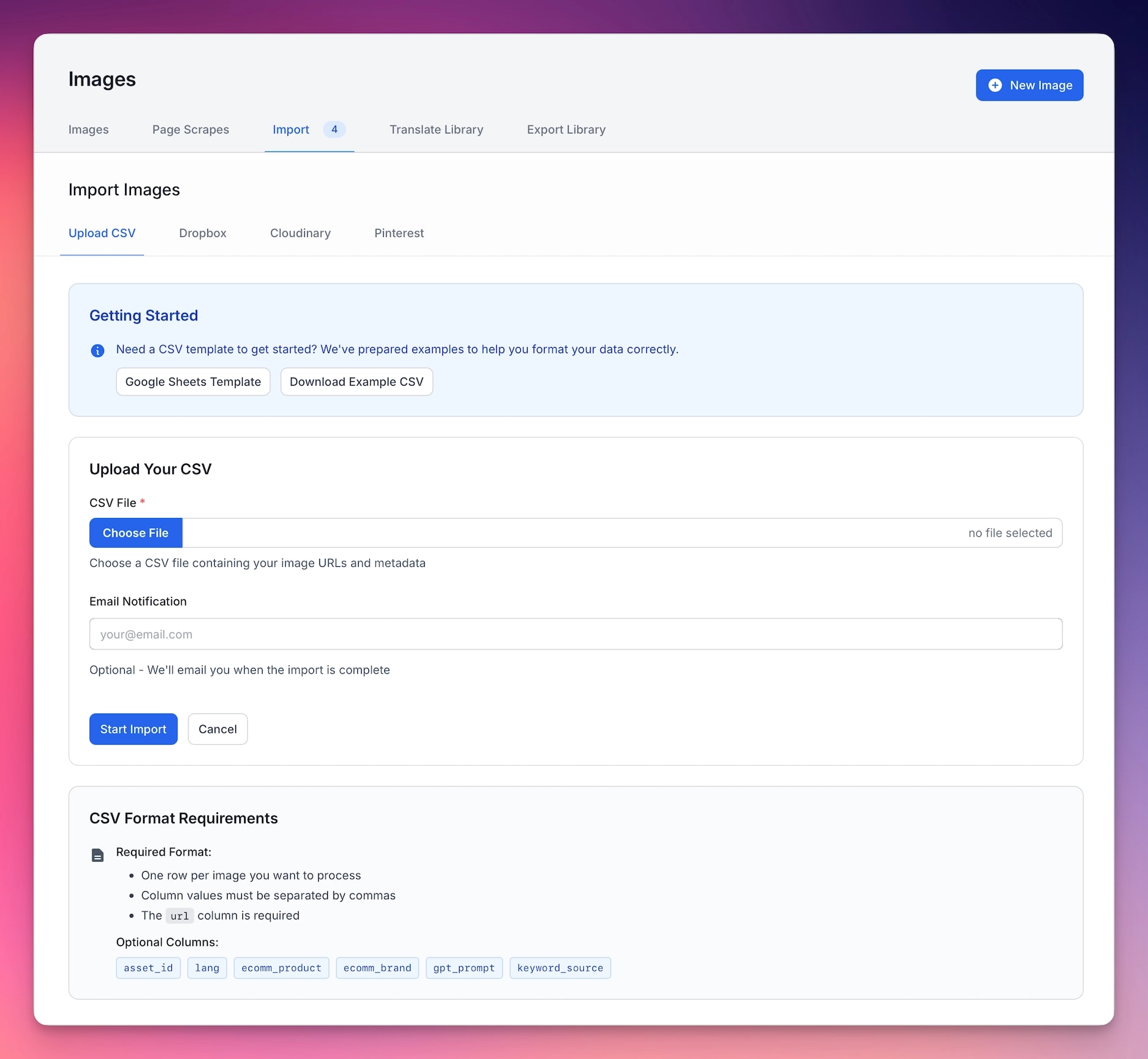
- Go to your Images library, then click on the Import button at the top.
- Select Upload CSV.
- Click Choose File and select your CSV with your image data.
- Enter an email address to be notified when the processing completes, then click Upload.
When you upload your CSV, you'll see a summary of the processing, and whether it was successful or not. If you have any obvious errors in your file, they will be reported on this page.
Info
CSV processing happens in the background, so please allow time for it to complete. You may not see your images added immediately, but they will usually appear within a few seconds after the upload.
Importing from Dropbox
You can select any number of image files from your Dropbox account and generate alt text for them.
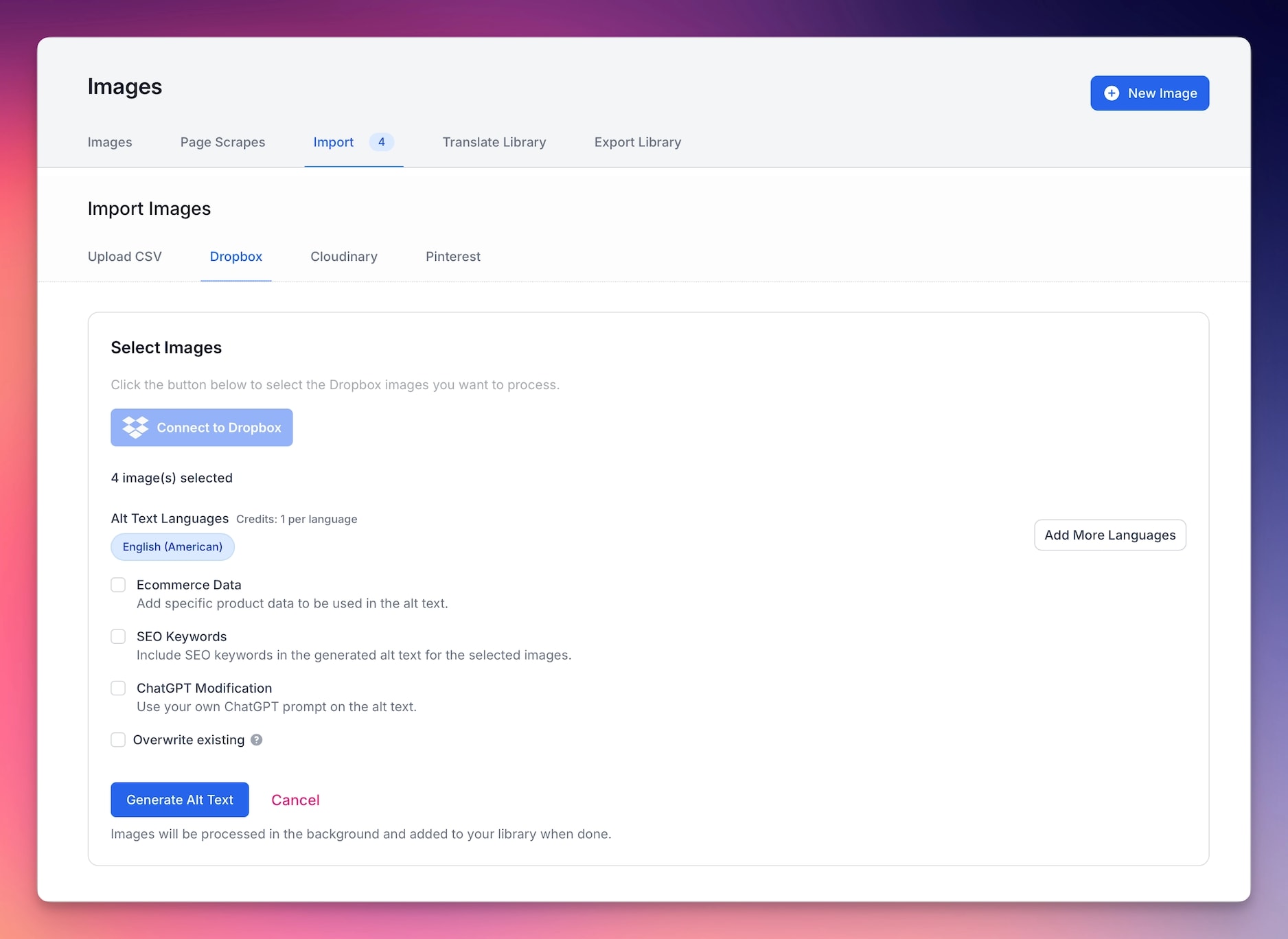
- Go to your Images library, then click on the Import button at the top.
- Select Add from Dropbox.
- Click the button to connect to your Dropbox account. You will see a window where you can login and select any number of image files to process.
- After you've made your selections, you can start the alt text generation by clicking the Generate Alt Text button.
Info
Processing of Dropbox images happens in the background, so please allow time for it to complete. You may not see your images added immediately, but they will usually appear within a few seconds after starting the process.
Importing from Pinterest
Note
Pinterest's API to update alt text and other pin data is still in beta. Some features may not work as expected until they stabilize their API. We are working with them to ensure their API to update alt text works properly.
AltText.ai can bulk process entire Pinterest boards, as well as individual pins that you select. Here's how to import and process images from your Pinterest account.
- Go to your Images library, then click on the Import button at the top.
- Select Add from Pinterest.
- If you haven't already connected your Pinterest account, you'll be prompted to authorize the connection to AltText.ai.
- You'll see a list of your Pinterest boards. Use the checkboxes to select entire boards, or click the Select pins button next to each board to select individual pins from a board.
- The Pinterest options section is used to control whether data is updated on the pins in Pinterest itself. When you check the box to update alt text on pins, we will update Pinterest with the generated alt text so it also appears on the Pinterest.com website. If you do not check this box, we'll just generate alt text for your pins and it will be in your AltText.ai library (the alt text on pinterest.com will not change).
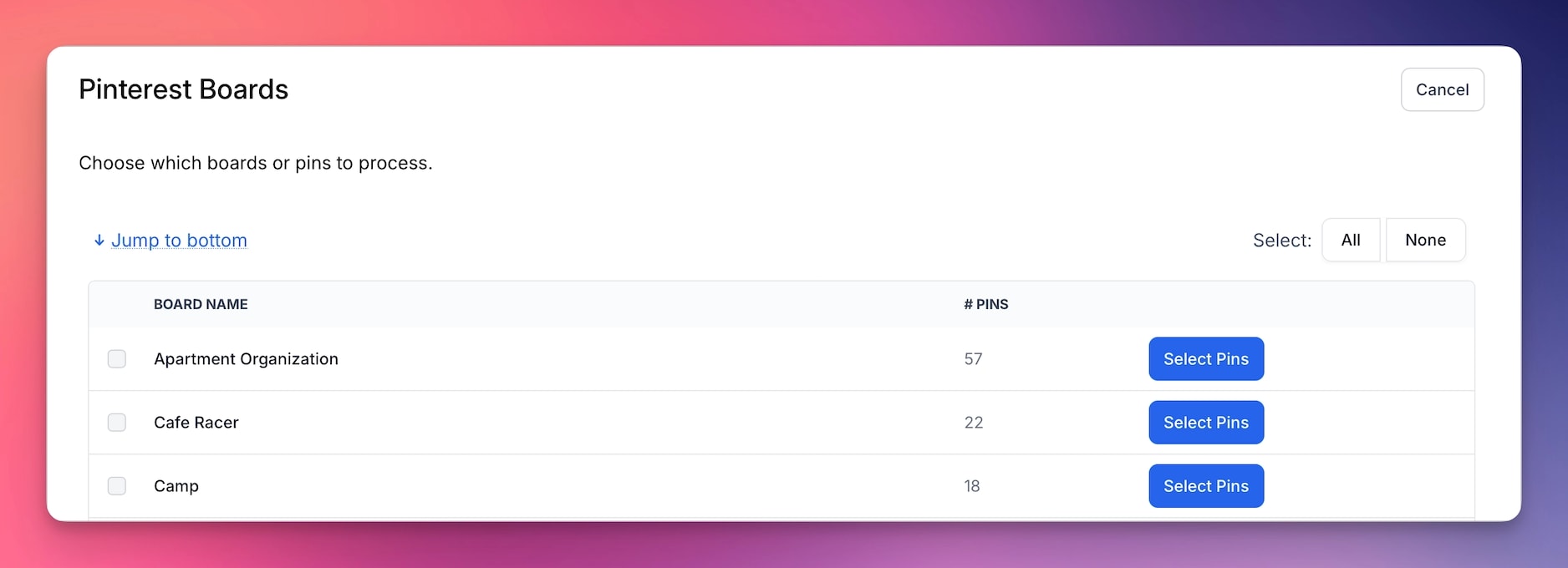

Info
Processing of Pinterest images happens in the background, so please allow time for it to complete. You may not see your images added immediately, but they will usually appear within a few seconds after starting the process.
Importing from Cloudinary
If you have existing images stored in your Cloudinary account, you can import and process them for alt text generation. This is separate from the Cloudinary integration and allows you to bulk process your existing image library.
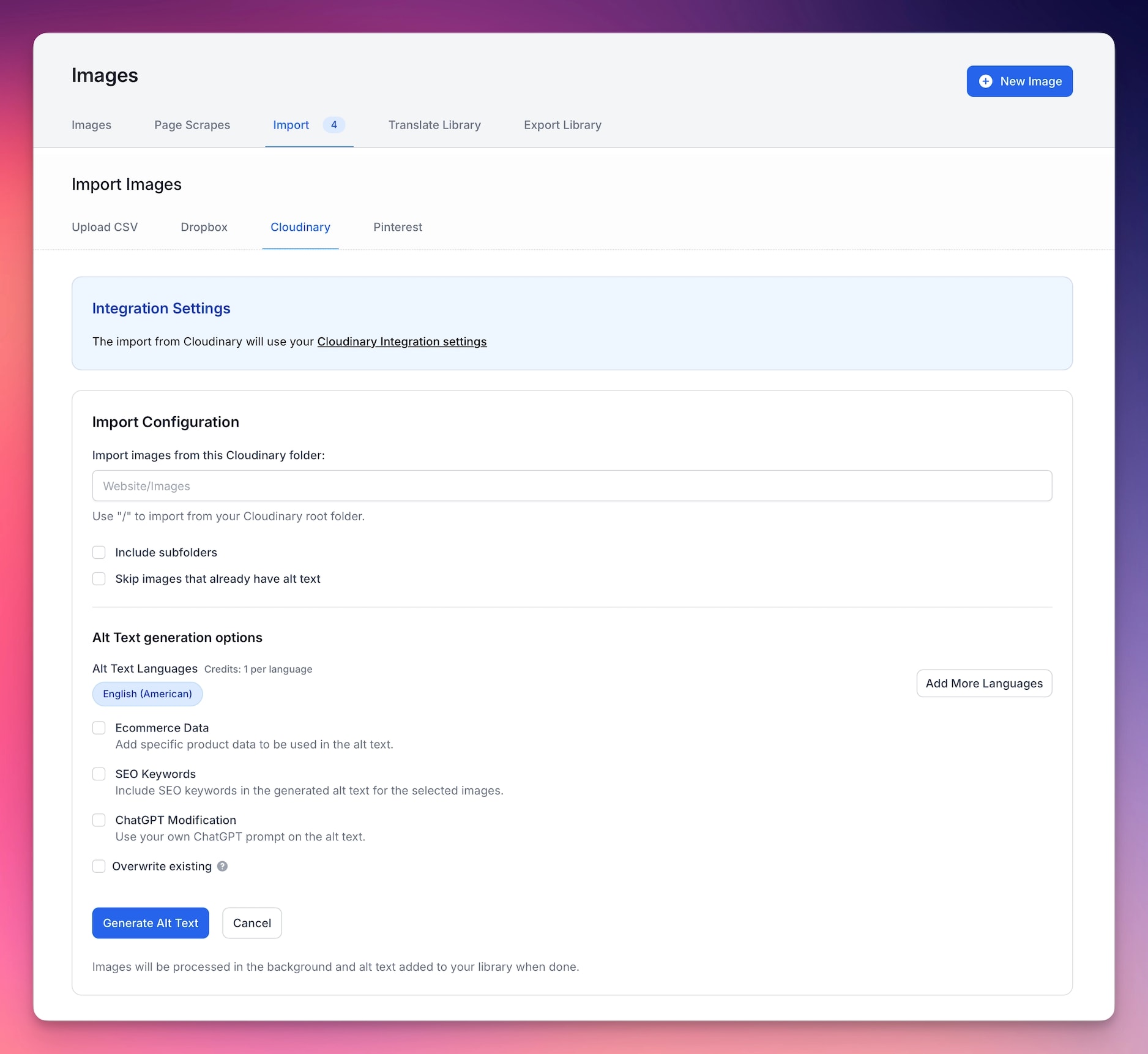
To import from Cloudinary:
- Go to your Images library, then click on the Import button at the top.
- Select Add from Cloudinary.
- Enter the folder path in Cloudinary where your images are located.
- Choose whether to include images in subfolders.
- Configure any additional processing options such as SEO keywords or ecommerce data.
When you start the import process, it will run in the background and begin generating alt text for your Cloudinary images. Unlike the Cloudinary integration which processes new uploads automatically, this import tool is for processing your existing image collection.
Info
Cloudinary import processing happens in the background, so please allow time for it to complete. You may not see your images added immediately, but they will usually appear within a few seconds after starting the process.
Translating Your Library
If you already have alt text in one language and need it translated to additional languages, you can translate your entire image library in bulk.
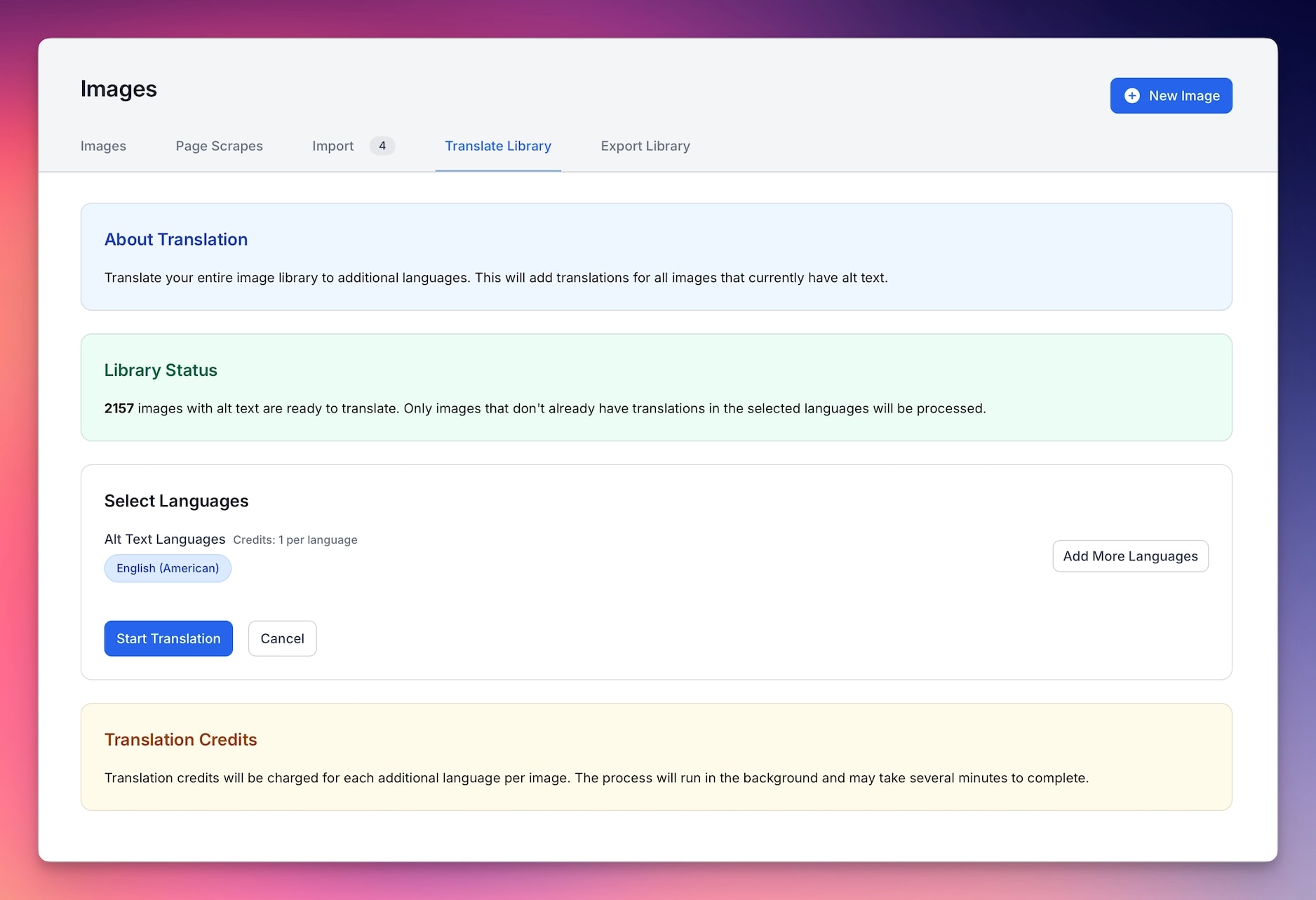
To translate your library:
- Go to your Images library, then click on the Translate Library button.
- Select the source language of your existing alt text.
- Choose one or more target languages for translation.
- Optionally filter images by date range, asset ID, or other criteria.
- Click Start Translation to begin the process.
The translation feature uses professional translation services to convert your existing alt text into other languages while preserving the meaning and context. This is useful for:
- Multilingual websites: Maintain consistent alt text across different language versions of your site
- International expansion: Quickly adapt your content for global markets
- Accessibility compliance: Ensure alt text is available in users' preferred languages
Info
Library translation happens in the background and may take some time for large collections. You'll receive an email notification when the translation is complete.
Scraping Images from a Web Page
When you need to get alt text for all the images on a single web page, use our Scrape Page tool. This is useful if you (or your clients) have an existing website that needs alt text added, and you do not have a good way to extract the image URLs from your internal system. Page scraping also lets you enter ecommerce data and SEO keywords for the generated alt text.
To start a page scrape, go to your Images library and click on Scrape Page at the top.
Page scraping consists of two steps:
-
Enter a URL (or provide HTML) and scrape the images from the page.
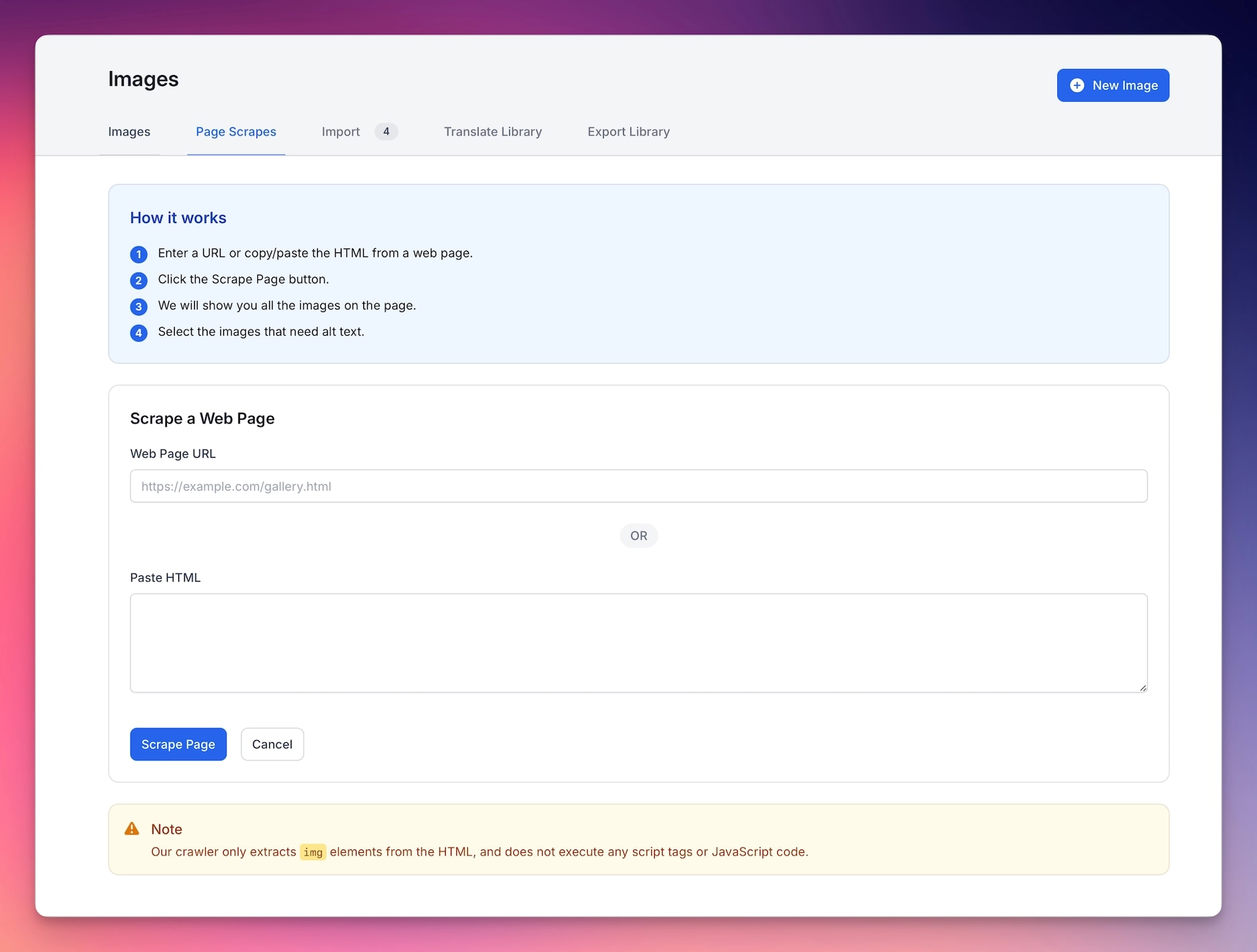
-
Select which images to process for alt text generation.
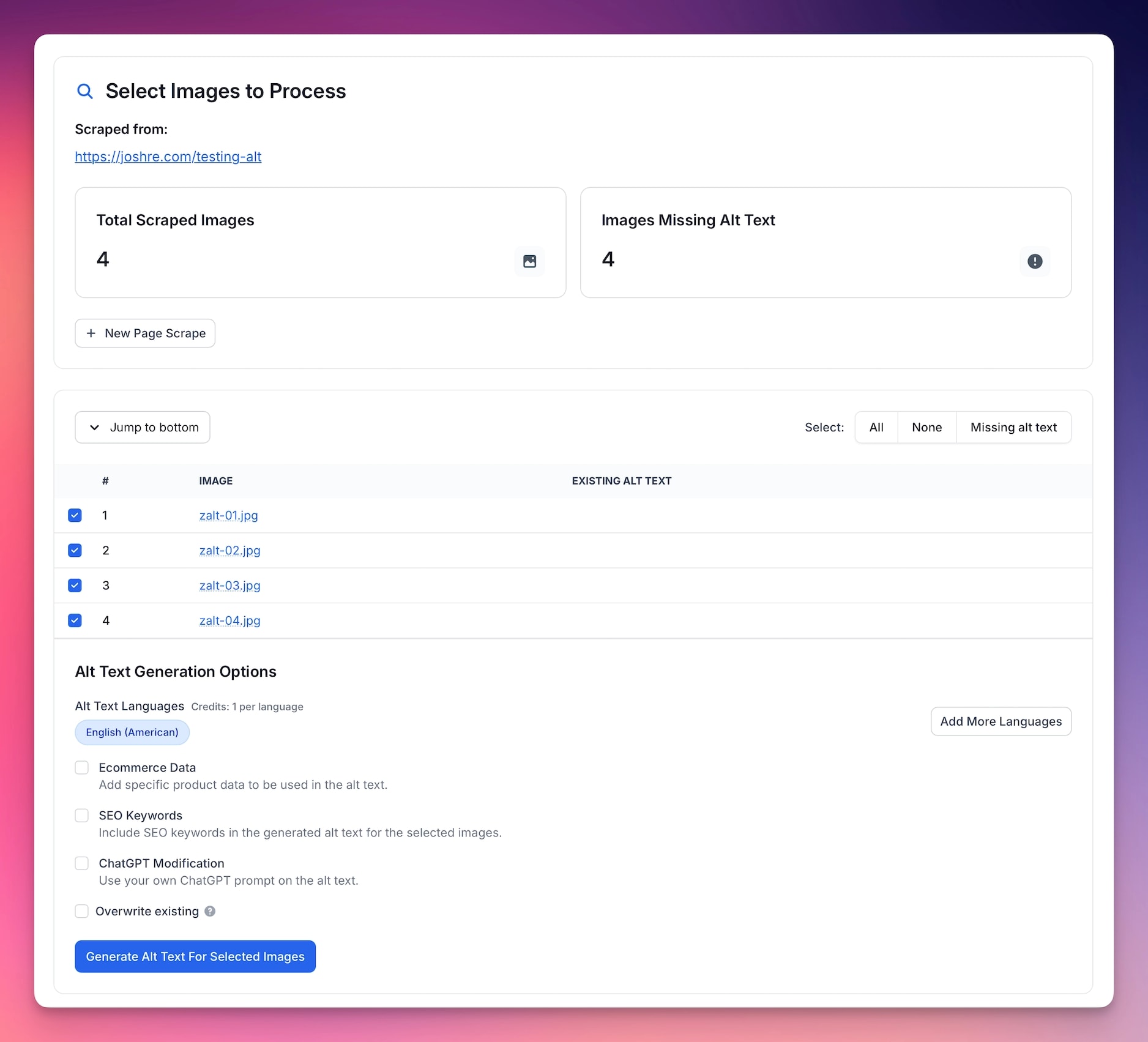
Info
Page scraping does not execute javascript when detecting images. Therefore, scraping a web page which uses javascript to dynamically load images (e.g. "infinite scroll" or "lazy loading") may not result in the images being extracted.